Looking for a way to ramp up your digital marketing strategy? Social media and referral programs already drum up plenty of peer-to-peer sharing on their own. So it makes sense to integrate social media into your referral program and create a word-of-mouth powerhouse!
But how do you best optimize your referral program for social media?
Today, we cover why referral programs and social media marketing go together like bread and butter. We also outline the can’t-miss best practices for integrating social media into your referral program, and highlight some top examples of brands that use social media in their referral program with amazing results.
Let’s dive in.
Referral programs and social media: The perfect match
Why do referral programs and social media go hand in hand? Referral marketing programs mobilize your happy customers to share with friends, and social media is where your customers are already sharing what they love.
Here are our top five reasons why social media integration is a must for any stellar customer referral program:
1. Social media is a natural outlet for widespread sharing
Social media is where people naturally go to share news, views, and preferences with friends – especially if they want to share with multiple friends at once.
Your customers are already on social, and they’re already talking about what they love. If they decide to share your brand as part of this natural cycle, that’s free advertising!
Integrating social media into your referral campaign makes it a lot easier for satisfied customers to share your brand to a wide audience when they want to.
2. Social referrals could create virality
If one of your current customers joins your referral program and shares on their profile, you could possibly reach hundreds, or thousands, of potential customers at once.
But even better, if you have an attractive product and referral incentive, those referred customers could end up sharing your brand with their own friends, and continue the cycle of sharing. If this continues, your referral marketing campaign could go viral (okay, maybe not as viral as Dropbox or Tesla, but it could spark significant growth from repeated sharing!)
3. Social media lets you reach ideal audience members
Your customers use social media to connect with their friends, who usually have similar needs, interests, demographics, and values. So when your existing customers share your brand on social, they’re likely connecting with members of your ideal audience – who they can relate to much more easily than your brand can.
4. People trust what their friends have to say
Especially in casual contexts like social media, people trust their friends’ recommendations far more than ads and messages that come straight from brands. If someone shares and raves about your brand on social, this word-of-mouth marketing is very potent.
The new referrals are more likely to check out your brand and purchase your products. Plus, referred customers usually have a higher customer lifetime value than non-referred customers.
Since your customers share with many friends at once on social media – and since referred customers are likely to refer their own friends – this trust effect multiplies. Social media referral programs are customer acquisition powerhouses!
5. Social media fosters social proof
Hand in hand with social media’s trust factor is social proof. When people aren’t sure whether to take an action or purchase a product, they mimic what they see their friends doing.
If someone sees their friend post about your referral offer, they’re more inclined to click the link, and make their first purchase, because they already know their friend had a positive experience with you.
Top 10 best practices for social media referral programs
Yes, refer-a-friend programs mobilize customers to promote your brand on your behalf. But even though referral programs and social media are especially powerful together, you can’t just add a social sharing feature to your program, then just leave it be and expect optimum sharing to happen.
To best harness the power of social media referrals, follow these top 10 best practices, and you’ll be on your way to a successful referral program.
1. Enable sharing on platforms your customers frequent most
Meet your customers where they are. What social platforms do they use most often to share with friends? Add social sharing buttons on those platforms, where sharing with friends is most natural for them. This also helps you establish brand presence on platforms your ideal audience frequents.
Be sure to pick more than one social media platform to integrate into your program, so customers can choose the platform that’s most convenient for them. Including multiple platforms will also open up a wider audience to promote brand awareness.
Check out how Freshly mobilizes advocates to share on five different social platforms!
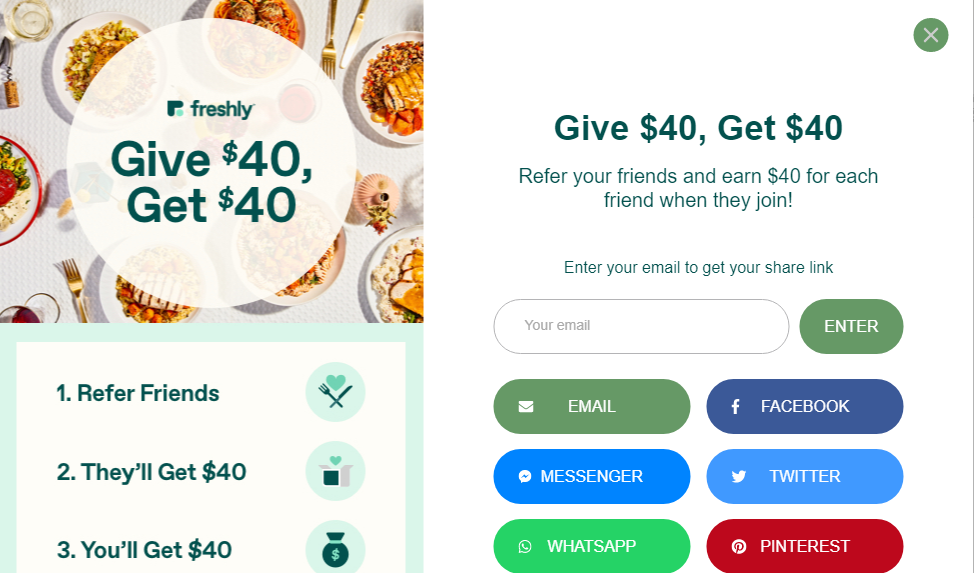
Also include an option to share a referral link by copying and pasting. This enables your customers to share on any social platform (even if you haven’t integrated a social share button) or even through direct message.
Think about your audience and their needs, and consider which of these sharing options will work best:
- Facebook Messenger
- Snapchat
- Other social networks (including regional favorites, if you’re an international company)
2. Promote your program regularly on social to mobilize advocates
You’ve put in the hard work to design your referral program, and you’ve integrated it into the right social media platforms. But you won’t get very far if your customers don’t know about your program and its social sharing options.
Remember to promote your referral program on social media, where your customers are already looking for updates about your brand. Promote the program at least once a month. This way, you’ll jog the memories of customers who are interested in sharing, but may have forgotten to refer their friends.
When you post about your program, be sure to highlight the referral reward with eye-catching images, and provide a direct link to your referral program for easy sharing. Add creative messaging that appeals to your customers. You could even use an emoji or two, as Pottery Barn Kids did. Or, you could highlight the referral reward in the post’s image, as Brandless did (find the example image in #7 below).
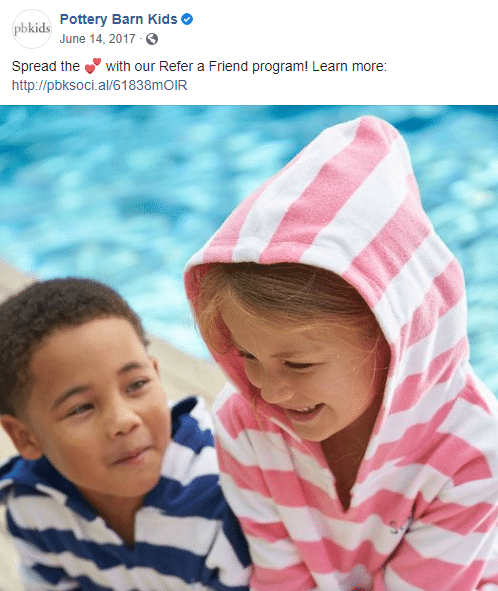
And don’t stick to the same post template every time. Rather, vary the referral messages and images to keep things interesting. If you change the referral reward (or add limited-time reward elements like bonuses or contests), make a post to let your audience know.
3. Promote your program in your social media bios
Your social media bio is an often-overlooked, yet effective, place to promote your program. Some bios let you place as much text as you want, but others (like Twitter and Instagram) limit your character count.
But you don’t need a long message to make an impact. Simply include a short blurb, like “we have a referral program,” “refer a friend,” or “share and get [reward]” in your bio. Then, add a direct link to your referral program page.
Check out how Zen Media uses this promotional technique below. They highlight the reward of a free upgrade for sharing, along with a link to their referral program page.
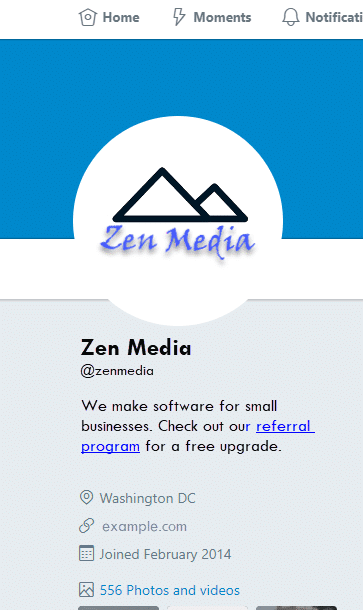
4. Offer double-sided referral rewards
Offering double-sided rewards (rewarding both the referrer and the new customer) is an overall referral program best practice. But it’s especially important on social media, where your customers are sharing with multiple friends at once.
You need to reward the advocate for bringing in new customers, as a way to keep them motivated. But if you don’t reward new customers for signing up, any referral program posts the advocates make will likely come across as too self-serving (given that they’re posting to their whole network at once).
But if you also give a reward to the referred friend, it increases the likelihood of more people clicking on the referral message – and eventually become your new customers.
5. Personalize sharing messages with the advocate’s name, message, and profile photo
One of the biggest benefits of social media referral programs is personalization. Since your advocates are sharing right from their social media profiles, you have plenty of ways to personalize the experience.
The easiest way is by including the advocate’s name or username in the update message that gets published when they share (e.g. “Jessica Huhn shared a post”). This is usually done automatically by the social media platform.
The advocate’s name should also be on the personalized landing page their friends arrive on when they click the referral link. By connecting to their social media profiles, this type of personalization is simple to add, especially if you’re using referral program software.
Another personalization option is within the referral message. This is the message friends receive or see on the advocate’s social profile. Let your advocates write part or all of the message they share to make the referral message feel authentic rather than automated.
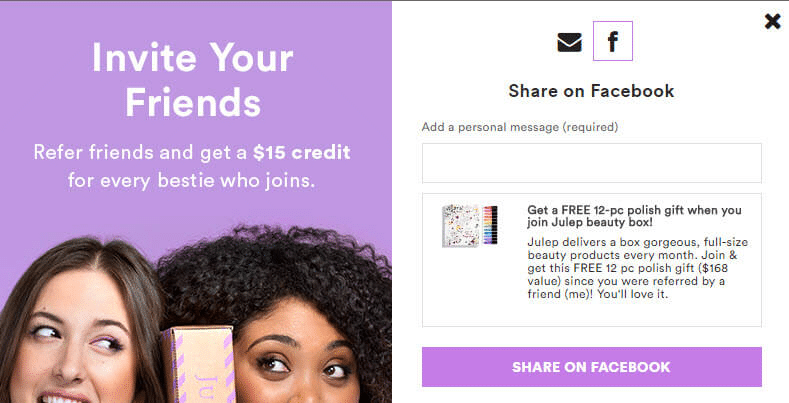
For an even more customized experience, you can also add the advocate’s message on the friend landing page, as well.
Finally, user-generated images promote social proof because they show your customers (and their friends!) support your brand. Consider integrating your advocate’s profile pictures into the sharing experience, especially since this opportunity is only available on social.
For example, when your advocates share via social media, you can include their social profile image on your friend landing page. This offers several benefits:
- It promotes social proof
- It provides another more personalized element
- The image also increases the chances that a friend will convert – studies have shown that landing pages with human faces more than double the conversion rate of landing pages without faces.
Check out how Airbnb uses the advocate’s name and profile on a personalized referral landing page.

6. Tailor the referral message to the conventions of each platform
Every social media platform is different, so don’t use the same cookie-cutter message and design for every one you integrate into your referral program.
Instead, customize the design of your referral message (the message advocates send to their friends) for each channel, so it looks and feels like all the other posts that friends see.
For example, Facebook allows for a bold headline, so you should place the reward front-and-center in the headline. Then include a hero image and compelling message that comes from the advocate.
Be sure the message feels personal, not like another ad (e.g., “I love how soft these Aero hoodies are!”). And as always, allow advocates to customize the message before sending.

Vivobarefoot’s referral program message for a Facebook page.
Twitter, of course, requires shorter messages. So get to the point rapidly.
But keep in mind, referral message tweets should feel even more personal, because they’ll appear among thoughts written in your advocate’s voice. They could possibly include a @mention of your brand’s Twitter account as well, or eye-catching emojis to make the most of the lower character count.
And of course, an image is always helpful.

Omsom’s referral message for Twitter, complete with fire emoji. Advocates can customize this message however they wish in the editor before publishing the tweet.
Instagram posts and Pinterest pins should always be image-centric. Let the image lead, with the text below it concisely explain the reward.
LinkedIn posts should feel more professional, while WhatsApp posts and messages should feel more casual.
In short, pay attention to how your customers communicate on each social channel. Then, make sure the referral message mirrors the format of their communication – but still stands out enough to entice friends to click. And always use first-person, from the advocate’s perspective.
7. Use imagery to your advantage
Whatever social networks you’re on, images are what draw someone’s eye to a post. Be sure to include vibrant images in your referral program social media promotions. The same goes for both the promotional messages to potential advocates, and the referral messages that advocates post to their friends.
Hero images of your rewards are often the best. Engage your audience with an image of the rewards your advocate and their friend can earn by participating in the referral program (by sharing with friends or by becoming a new customer, respectively). If you show images of people enjoying the reward, even better!
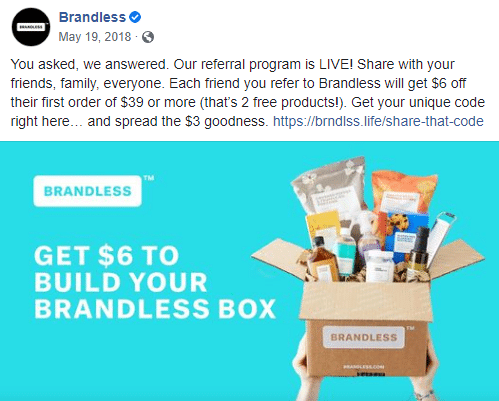
8. Optimize your program for mobile
Every day, your customers spend more than five hours on their smartphones. A good chunk of this time is spent using social media to connect with friends, especially in this climate of increased virtual connections.
And with one-tap access to apps, people mostly access social media on their mobile devices. In fact, over 61% of North American social media use is via mobile devices (and this number is even higher in other regions, such as East Asia).
So what does this mean? Your social media referral program needs to be optimized for a mobile experience.
One easy way to create a mobile-centric referral experience is to make sure sharing buttons are big and bold on mobile screens, and positioned where customers can easily click or tap them with their thumbs.
Make sure customers can find these sharing buttons in as few taps as possible, with an intuitive flow. It’s also best to keep your program description simple, and include a pre-filled message so advocates don’t have to type one out on their phone keyboards.
9. Spotlight top advocates on social
Customers love being appreciated, so why not use your social media channels to spotlight your best advocates?
Highlight an “advocate of the month” with how many referrals they’ve made, why they love your brand, and some personal info unrelated to your company. You could choose these advocates based on their number of monthly referrals, or their number of lifetime referrals. Or, you could spotlight advocates when purchases from their referrals total more than a target amount.
Spotlighting top referrals on social shows your appreciation for the customers who are helping your company grow, and drums up friendly competition among advocates. Customers who haven’t shared yet will likely be motivated to share, because they’ll want a spotlight of their own.
It’s also another effective way to promote your referral program on social media. And by taking time to show your appreciation, you also show how much you value your customers and their support.
10. Finally, use referral software for seamless social media integration
Whether you run an ecommerce store, B2B corporation, or startup, referral software is essential for running a smooth program that’s integrated into the best social media channels.
The right tool will help you track all referrals made on social media and beyond, easily attribute them to the advocate who fueled them, and instantly trigger rewards for advocates and new customers the moment you get a sale.
It also lets you easily customize messages shared on social, and activate referrals on other marketing channels, including email, text messaging, and anywhere advocates choose to share via a referral link.
Our referral program software here at Referral Rock easily integrates your program with platforms like Facebook, Messenger, Twitter, LinkedIn, WhatsApp, and Pinterest. Skip the stressful DIY, and quickly set up a program with the social sharing you want in just a few clicks!
Check out how you can accelerate referrals on social, and beyond, with Referral Rock.




